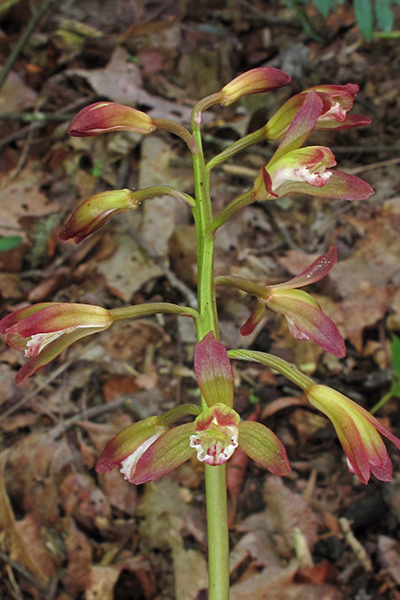by R. Haven Wiley, Ph.D.
Biology Department (retired), University of North Carolina at Chapel Hill
Orchids are more than just flowers! In fact, most of them don’t have flowers to which most people would give a second look. Some have flowers so inconspicuous that they almost never get even a first look. But the other parts of orchids — the thick corms or tubers, the puffs of dust-like seeds, and the tough capsules that contain the seeds — lead just as fascinating lives, often secret and even now poorly understood by scientists.
As a graduate student, many decades ago, I learned that orchids exemplify two of the plant world’s most intricate forms of symbiosis: associations with soil fungi and pollination by insects. Unlike a kernel of corn where the embryo is surrounded by nutrient-rich tissue
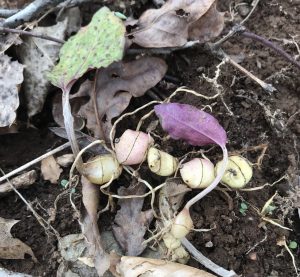
(endosperm) which nourishes the seedling, minute orchid seeds have almost no endosperm and thus have no stored nutrients to fuel germination, much less initial growth of a seedling. Instead of being nourished by endosperm, an orchid seedling relies on a fungal partner — its mychorrhizal associate — for nourishment. The mycorrhizal associations (the interplay between fungus and plant) take place in the orchid’s corms. In some species of orchids the corms resemble globular bulbs, while in other species the corms resemble pudgy roots. For pollination, orchids rely on bees, wasps, moths, and occasionally other insects, to carry small sacs of pollen from one plant to another, or sometimes from one flower to another on the same plant, or even just to the stigma of the same flower. Many orchids provide special odors or nectar to attract these insects.
As in other kinds of flowers, nectar is often provided at the end of a narrow tube that extends backward from a small orifice in the center of the flower, and thus requires a long tongue to reach it. In a pioneering work on the pollination of orchids, his first book after On the Origin of Species, Charles Darwin had used these nectar-producing tubes as examples of the precise adaptions of complex structures by natural selection.
In this book, The Various Contrivances by Which British and European Orchids are Fertilized, Darwin made a famous prediction of the course of evolution. Based on the earlier description of an orchid in Madagascar with an extraordinarily long tube for nectar, he felt sure that it must be pollinated by a moth, at that time unknown, with a corresponding extraordinarily long tongue. Darwin’s hunch was justified when such a moth was later discovered.
Orchids are now known to use astonishingly bizarre tricks in order to stick their sacs of pollen onto insects. One of my favorites, employed by grass-pink orchids Calopogon, common species in much of eastern North America, was described in 1887 just too late for Darwin to read about. A grass-pink provides an extraordinary landing pad for a pollinating bee. The column of its flower, which extends upward from the lip, is festooned with a yellow brush resembling ripe protein-rich pollen, such as a bee might harvest to feed to its own larvae. The pollen though is fake, and when an unsuspecting bee lands, the column buckles and dumps the bee upside down on the orchid’s sticky sacs of pollen. The bee is then summarily jettisoned from the flower, upside down, with a back-pack of orchid pollen but nothing to feed the bee’s larvae. If the bee makes the same mistake at another such orchid, it might leave the sticky sac of orchid pollen on that orchid’s stigma to fertilize the orchid’s seeds.
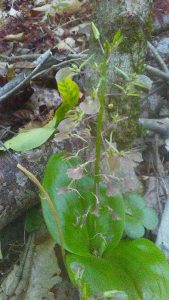
Aware of these astonishing, albeit minimal, factoids about orchids, I have always had an eye out for them as I pursued my studies of other organisms. Mating displays of grouse, cooperation by wrens, and songs of warblers kept me busy for decades. I gradually realized that all of the behavior I was studying was some form of communication and that what I was trying to understand was the evolution of communication by natural selection. Eventually I worked out some of the relevant math and published a book on the evolution of communication, which clarified, at least in my mind, two key features of communication. It was (1) inevitably noisy, and it would (2) never evolve to avoid the possibility of deception. Last May, about the time I had become thoroughly discouraged by my attempts to convince other people of the deep significance of these two revelations, my wife Minna and I stumbled, literally stumbled, onto some Liparis liliifolia (lily-leaved twayblade), full of flowers on a damp wooded slope. The tiny but intricate flowers, a translucent purple in the shade of the trees, started me thinking about orchids again.
After an afternoon reading Darwin’s Orchids by Edens-Meier and Bernhardt (University of Chicago Press, 2014) and then some poking around in botanical journals and the UNC Herbarium, I began to wonder if orchids weren’t nature’s Masters of Deception. Deception — what I had just written a book about! It was easy to be convinced that pollination by many orchids requires crass, outright deception of insects. It is also possible that the mycorrhyzal associations of many orchids involves deception of the fungi. One might thus say that these orchids practice deception from the ground up! Is there any other organism that lives by deception from birth to death — that is, for both reproduction and survival? In view of my previous work on the evolution of communication, are orchids the epitome of my conclusion that communication never evolves to avoid deception? Does this thorough reliance on deception explain any of the many extraordinary features of orchids: their unpredictable flowering, their lack of chemical defenses against herbivory, their abrupt and unusual phenologies, their scarcity and erratic distributions, and their extraordinary diversification. Without exaggeration, there are probably more species of orchids than of any other plant family — about 1 in 10 of all species of flowering plants is an orchid.
Nevertheless, I can confidently confirm that finding orchids is not at all easy. Once alerted to the peculiar
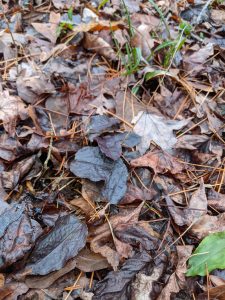
interest of orchids, Minna and I spent our outdoor time this past year scrutinizing the ground in many North Carolina forests, fields, and swamps — plant by plant. We found some beauties and some rarities. We paid for some of them in sweat and chiggers! Since November we have become intimate with the two species with winter leaves. We have learned (and in most cases confirmed previous reports) that leaves of Tipularia discolor (crane-fly orchid) and Aplectrum hyemale (putty-root) do not change, once emerged, in coloration or size (although some Tipularia leaves become suffused with more purple as they senesce in early spring). Only a small percentage of plants with leaves have inflorescences, which eventually become straw-like stems with capsules of seeds. These stems, much more than the leaves, are often partly or entirely eaten by herbivores (deer and insects
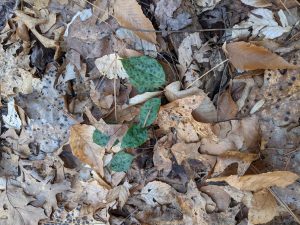
probably). As the first warm days of spring arrive, well before trees have created any shade, these orchids’ leaves are wilting and disintegrating. Not until a month or more later, with no leaves at all, do a few individuals of Tipularia and Aplectrum produce flowers. Once again, orchids do not seem to follow expectations. In early spring the leaves of other plants with winter-green leaves are refreshing their color and reaching upward. Many other early spring bloomers do not bother with winter leaves at all. Their leaves only appear in time to take advantage of the scant month of warmth and sunshine before the leaves overhead block the light.
In the coming year or two, Minna and I would like to locate populations of a variety of orchids, so that we can monitor their seasonal and annual variation in growth, flowering, and seeding. Will we then understand more about the consequences of their deceptive lives? Will any of the peculiarities of orchids make more sense as predictions from deception? Will it become easier to realize that plants, fungus, and insects communicate with each other, make their own decisions in accordance with natural selection or by trial-and-error learning, and deceive each other — much as do humans?
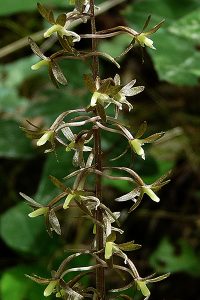
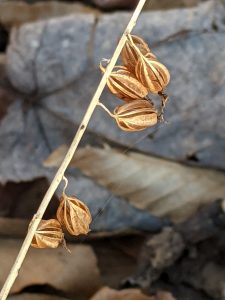
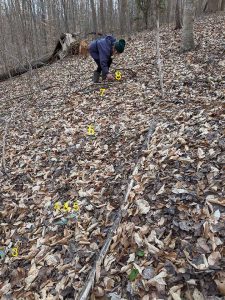
1. McCormick, Melissa K., D. Lee Taylor, Katarina Juhaszova, Robert K. Burnett Jr., Dennis F. Whigham, and John P. O’Neill. 2012. Limitations on orchid recruitment: not a simple picture. Molecular Ecology 21: 1511-1523. doi: 10.1111/j.1365-294X.2012.05468.x
https://www.fs.fed.us/pnw/pubs/journals/pnw_2012_mccormick001.pdf
Top photo: Aplectrum hyemale by Alan M. Cressler
